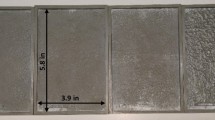Abstract
Casting surface specifications are set based on aesthetics, functionality, or a combination of both. To classify casting surfaces, visual inspections are performed by an operator who compares the casting surface to pictures or comparator plates (e.g., metal, plastic) that represent a certain roughness level. This inspection process is highly subjective, and disagreements arise on the acceptance of a casting between the casting producer and buyer. To minimize these disagreements and use developments in 3D scanning, this study aims to develop a digital surface characterization method. The method developed and implemented in this study utilizes underlying geometry estimation, abnormality detection, and a new roughness characterization formula based on a variogram to determine a surface roughness value. Tests were done to compare the new roughness characterization formula with existing quantification methods (i.e., Sa, Sq) and to compare the results of the method with human operators. The tests indicated that the variogram roughness was able to differentiate between the roughness levels of the current surface roughness standards GAR-C9 and SCRATA. In addition, the results are repeatable as well as reproducible and agree with operator judgment based on a ranking comparison between the operator and the digital method. Overall, the digital surface roughness method has the potential to improve the communication between casting suppliers and designers and make the surface roughness classification more reliable and repeatable.















Similar content being viewed by others
References
P. Eubanks, A. Crawford, L. Johnson, G. Larkin, W. Patschke, E. Schoefer, Steel Founders’ (Steel Founders’ Society of America. Crystal Lake, Alloy Casting Institute, 1969)
MSS SP-55, Quality Standard for Steel Castings for Valves, Flanges and Fittings and Other Piping Components (Visual Method) (Manufacturers Standardization Society of the Valve and Fittings Industry, New York, 2016)
A802/A802M − 95 1982 (2015), Standard Practice for Steel Castings, Surface Acceptance Standards (Visual Examination. ASTM International, West Conshohocken, 2015), pp. 3–5
Gar Electroforming, C-9 Cast Microfinish Comparator (Gar Electroforming, 2019). https://garelectroforming.com/index.php?route=product/product&path=59_64&product_id=73. Accessed 18 Mar 2019
T.J. Schorn, AFS Trans. 114, 17–23 (2006)
G. Daricilar, F. Peters, Int. J. Met. (2011). https://doi.org/10.1007/BF03355514
F. Peters, R. Stone, K. Watts, P. Zhong, A. Clemons, AFS Trans. 121, 8 (2013)
D.-H. Lee, N.-G. Cho, Meas. Sci. Technol. (2012). https://doi.org/10.1088/0957-0233/23/10/105601
X.D. Yang, J.C. Li, T.B. Xie, Key Eng. Mater. (2007). https://doi.org/10.4028/www.scientific.net/KEM.364-366.750
H.T. Lancashire, A simulated comparison between profile and areal surface parameters: Ra as an estimate of Sa (Arxiv, 2017). http://arxiv.org/abs/1708.02284. Accessed 23 Oct 2019
U.C. Nwaogu, N.S. Tiedje, H.N. Hansen, J. Mater. Process. Technol. (2013). https://doi.org/10.1016/j.jmatprotec.2012.08.008
M.M. Voelker, F.E. Peters, Mater. Perform. Charact. (2008). https://doi.org/10.1520/MPC20160014
D.M. Shivanna, M.B. Kiran, S.D. Kavitha, Procedia. Mater. Sci. (2014). https://doi.org/10.1016/j.mspro.2014.07.416
F. Darboux, P. Davy, C. Gascuel-Odoux, C. Huang, CATENA (2002). https://doi.org/10.1016/S0341-8162(01)00162-X
E.C. Kamphorst et al., Soil Sci. Soc. Am. J. 64(1992), 1749–1758 (2000). https://doi.org/10.2136/sssaj2000.6451749x
T. Belem, F. Homand-Etienne, M. Souley, Rock Mech. Rock Eng. 33, 217–242 (2000)
ASME 846.1-2009 Section 1, Surface Texture (Surface Roughness, Waviness and Lay) (ASME, New York, 2009)
FARO, FARO Edge and ScanArm ES (FARO, 2013). ftp://ftp4.jgc.gr/Pdf_files/TechSheet_FAROEdge.pdf. Accessed 06 Sep 2018
Acknowledgements
This American Metalcasting Consortium (AMC) project is sponsored by the Defense Logistics Agency Troop Support, Philadelphia, PA, and the Defense Logistics Agency Information Operations, J62LB, Research and Development, Ft. Belvoir, VA.
Author information
Authors and Affiliations
Corresponding author
Additional information
Publisher's Note
Springer Nature remains neutral with regard to jurisdictional claims in published maps and institutional affiliations.
Disclaimer: The publication of this material does not constitute approval by the government of the findings or conclusion herein. Wide distribution or announcement of this material shall not be made without specific approval by the sponsoring government activity.
Rights and permissions
About this article
Cite this article
Schimpf, D.W., Peters, F.E. Variogram Roughness Method for Casting Surface Characterization. Inter Metalcast 15, 17–28 (2021). https://doi.org/10.1007/s40962-020-00451-0
Published:
Issue Date:
DOI: https://doi.org/10.1007/s40962-020-00451-0




